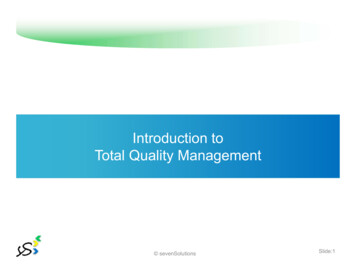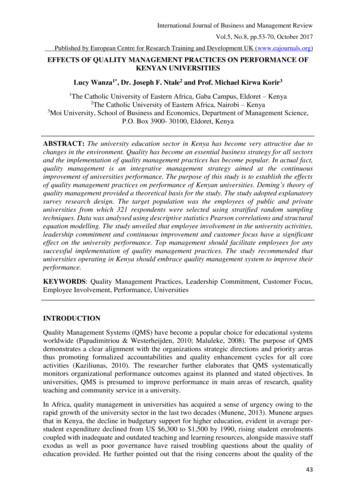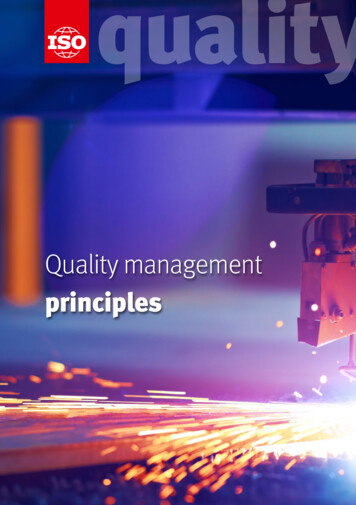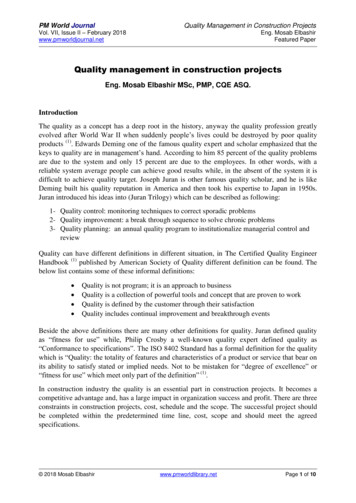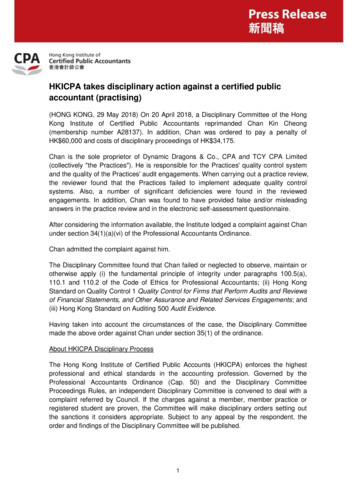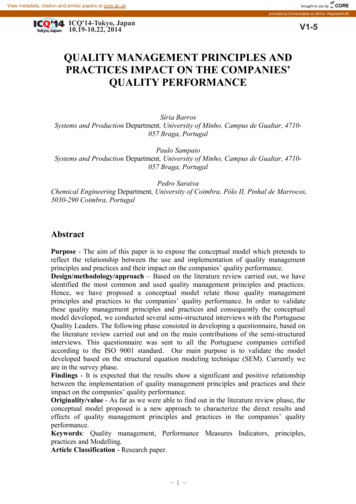
Transcription
View metadata, citation and similar papers at core.ac.ukbrought to you byCOREprovided by Universidade do Minho: RepositoriUMICQ'14-Tokyo, Japan10.19-10.22, 2014V1-5QUALITY MANAGEMENT PRINCIPLES ANDPRACTICES IMPACT ON THE COMPANIES’QUALITY PERFORMANCESíria BarrosSystems and Production Department, University of Minho, Campus de Gualtar, 4710057 Braga, PortugalPaulo SampaioSystems and Production Department, University of Minho, Campus de Gualtar, 4710057 Braga, PortugalPedro SaraivaChemical Engineering Department, University of Coimbra, Pólo II, Pinhal de Marrocos,3030-290 Coimbra, PortugalAbstractPurpose - The aim of this paper is to expose the conceptual model which pretends toreflect the relationship between the use and implementation of quality managementprinciples and practices and their impact on the companies’ quality performance.Design/methodology/approach – Based on the literature review carried out, we haveidentified the most common and used quality management principles and practices.Hence, we have proposed a conceptual model relate those quality managementprinciples and practices to the companies’ quality performance. In order to validatethese quality management principles and practices and consequently the conceptualmodel developed, we conducted several semi-structured interviews with the PortugueseQuality Leaders. The following phase consisted in developing a questionnaire, based onthe literature review carried out and on the main contributions of the semi-structuredinterviews. This questionnaire was sent to all the Portuguese companies certifiedaccording to the ISO 9001 standard. Our main purpose is to validate the modeldeveloped based on the structural equation modeling technique (SEM). Currently weare in the survey phase.Findings - It is expected that the results show a significant and positive relationshipbetween the implementation of quality management principles and practices and theirimpact on the companies’ quality performance.Originality/value - As far as we were able to find out in the literature review phase, theconceptual model proposed is a new approach to characterize the direct results andeffects of quality management principles and practices in the companies’ qualityperformance.Keywords: Quality management, Performance Measures Indicators, principles,practices and Modelling.Article Classification - Research paper.1-1-
ICQ'14-Tokyo, Japan10.19-10.22, 20141. IntroductionThere is a considerable number of publications that is focused in the link betweenquality management and organizational performance. However, the analysis of thedirect effects and results of the quality management principles and practices inPortuguese organizations quality performance is an innovative issue.The American Society for Quality (ASQ) research entitled “The Global State of QualityResearch Overview” (2013) highlight the best quality management organizationalstructure which includes the quality management principles and practices that lead to amaximization of the organization results.From the ASQ study, explanatory key factors, which are extensively being used duringthe whole research and which are highly related to the variability in the application ofprinciples and practices, were established. 1) There are significant differences in the useand application of quality management and practices in organizations from the industrysector as well as in organizations from the service sector. 2) There is a general idea thatthe organizations of higher dimension tend to use more mature quality practices.Although this idea is appropriate for various practices, in general, the dimension of theorganization has less impact than the organization activity sector concerning theapplication of mature quality practices. 3) There is no relevant indication that the use ofquality principles and practices differs per region, generally. Some variations do exist,but normally they are related to the dimension, sector or other unidentified factors.(ASQ, 2013).The aim of this research is to develop and propose a conceptual model that reflects therelationship between the implementation of principle and practices quality managementand their impact on the quality performance of the Portuguese organizations.The goal of this research is to analyze if the implementation of QMPPs results in animprovement of companies quality performance, namely in manufacturing and service sectors.Our final conceptual model will be statistically validated based on a survey that will besent to the Portuguese companies. The structural equation modeling (SEM) will be ourstatistical methodology support.2. Quality ManagementQuality Management (QM) has been defined as a “philosophy or an approach tomanagement” made up of a “set of mutually reinforcing principles, each of which issupported by a set of practices and techniques” (Dean and Bowen, 1994).QM represents one of the most significant research themes in operations management.Today QM is a widely accepted organizational goal for several companies (Nair, 2006).With the tremendous growth of literature in both academic and practitioner orientedoutlets, the term QM has been diluted to mean different things and the scope ofactivities underlying QM lack consensus (Watson and Korukonda, 1995).The study conducted by Sousa and Voss, (2002), commenting on the validity of qualitymanagement, conclude that, ‘‘QM as espoused by its founders, can be reliablydistinguished from other strategies for organizational improvement and there issubstantial agreement in the literature as to which practices fall under the QMumbrella’’.2.1Quality Management Principles and Practices2-2-
ICQ'14-Tokyo, Japan10.19-10.22, 2014The quality practices of an organization (which take place within a quality culture orcontext) are defined as the actions and procedures undertaken by a company ororganization to ensure the delivery of a high-quality service or product.Sousa and Voss, (2002) mention that “practices are the observable facet of QM, and it isthrough them that managers work to realize organizational improvements. Principles aretoo general for empirical research and techniques are too detailed to obtain reliableresults. The quality management principles can be used by senior management as aframework to guide their organizations towards improved performance. There are manydifferent ways of applying these quality management principles. The nature of theorganization and the specific challenges it faces will determine how to implement them.Some of the conflicting results reported in the literature may have to do with differentlevels of analysis of QM. Several studies operationalized QM as a multi-dimensionalconstruct (Anderson et al., 1995; Flynn et al., 1995; Mohrman et al., 1995; Powell,1995; Adam et al., 1997; Grandzol and Gershon, 1997; Ahire and O’Shaughnessy,1998; Forza and Flippini, 1998; Rungtusanatham et al., 1998; Dow et al., 1999; Samsonand Terziovski, 1999; Das et al., 2000; Wilson and Collier, 2000; Ho et al., 2001;Kaynak, 2003) while others conceptualized it as a single construct (Hendricks andSinghal, 1996, 1997; Chenhall, 1997, Choi and Eboch, 1998; Easton and Jarrell, 1998;Douglas and Judge, 2001).It would be relevant that future studies should make explicit at what level they areaddressing QM content: principles, practices or techniques.Researchers should also strive for a standardization of definitional terms. For example,different terms have been used for “practices”, such as “factors” (Saraph et al., 1989;Powell, 1995), “implementation constructs” (Ahire et al., 1996; Anderson et al., 1995)and “interventions” (Hackman and Wageman, 1995).Based on the literature review carried out, we have identified the most common and themost implemented quality management principles and practices. It is important to referthat this selection was based on two sectors which will be target of our study:manufacturing and service. Hence, it is believed, in fact, that these quality managementpractices and principles are comprehensive because they: Have highest frequency of occurrences by different researchers in the serviceindustries and identified as the key aspects in TQM implementation in bothmanufacturing and service industries (Saraph et al., 1989; Antony et al., 2002; Zhanget al., 2000; Khamalah and Lingaraj, 2007); Represented the hard and soft aspects of quality management; Encompass the most prestigious quality award and standards criteria widely acceptedby quality management scholars and practitioners; Have been considered as critical practices in quality management (Sila andEbrahimpour, 2002); Significantly associated in services and in the promotion of service quality (Beharaand Gundersen, 2001).In order to do a preliminary validation of the quality management practices andprinciples as well as the quality performance indicators selected, we conducted a seriesof semi-structured interviews with national and international Quality Leaders, such as:academics, specialists in this area, managers and consultants.Therefore, the eight generic quality management principles identified (PA1-PA8):Leadership, Customer Focus, Employee Involvement and Commitment, HRManagement (incentive and recognition), Strategic Planning Management, ProcessManagement, Supply Chain Management, Continuous Improvement and Innovation aswell as the quality management practices (PB): Quality Tools and Business Excellence3-3-
ICQ'14-Tokyo, Japan10.19-10.22, 2014Models, were valued in a scale from 1 (Nothing Important) to 5 (Extremely Important)by each Quality Leader Interviewee. All data collection and following statistic analysiswhich is illustrated in figure 1, allowed the presentation of the conclusions presented inthe next paragraphs.Figure 1 – General view of the quality management principles and practices.Through figure 1 analysis, one may conclude that from the quality managementprinciples presented (PA1-PA8), we may distinguish as Extremely Important: Leadership,Customer Focus and Process Management; as Very Important: Employee Involvementand Commitment, HR Management (incentive and recognition), Strategic PlanningManagement, Process Management, Supply Chain Management, ContinuousImprovement and Innovation. The Quality Tools and Business Excellence Models (PB)were distinguished as Very Important.It is important to mention that, through the course of the interviews, it was proposed thatquality management practices category (PB) could be divided in three dimensions, suchas: a) Quality Tools; b) Quality standards and c) Business Excellence Models.Therefore, in our present research, based on the validation and on the maincontributions of the semi-structured interviews phase, the quality managementprinciples that are going to be the target of study are: Leadership, Customer Focus,Employee Involvement and Commitment, HR Management (incentive and recognition),Process Management; Strategic Planning Management, Supply Chain Management andthe Continuous Improvement and Innovation. On the other hand, as mentioned above,the quality management practices that are going to be the target of study are thefollowing dimensions: Quality tools, Quality standards and the Business ExcellenceModels (Figure 4: Conceptual Model: Relationship between QMPPs and their impact inquality performance).2.2Quality Performance Measures Indicators4-4-
ICQ'14-Tokyo, Japan10.19-10.22, 2014Numerous studies have examined the positive and negative (or non-significant)relationships between quality principles and practices and various performancemeasures indicators. While examining the relationship between quality principles andpractices and performance scholars have used different performance types such asfinancial, innovative, operational and quality performance.Sousa and Voss, (2002) mentioned that quality management practices have a significantand strong impact on quality (internal process and product) and operational performance.In some studies a multidimensional operationalization of performance is considered(Mohrman et al., 1995; Das et al., 2000; Wilson and Collier, 2000) while othersconsidered single performance construct (Anderson et al., 1995; Ahire andO’Shaughnessy, 1998; Rungtusanatham et al., 1998; Ho et al., 2001).In this study, we considered quality performance as our indicator for measuringcompany’s performance. The reasons for choosing quality performance as an indicatorfor measuring company’s performance are: It can be measured and reflected into number of ways as articulated in past empiricalstudies on TQM (Ahire et al., 1996; Flynn et al., 1994; Su et al., 2001; Yang, 2006;Arumugam et al., 2008; Prajogo and Sohal, 2003; 2004). It has been used by Malcolm Baldrige National Quality Award (MBNQA) modelunder the ‘quality results’, the only criterion used for organizational performancemeasurement. MBNQA model that represent TQM practices is accepted by severalresearchers across the world (Ahire et al., 1995; Dean and Bowen, 1994; Juran, 1998;Prajogo and Sohal, 2003; 2004); Several past research studies on TQM and organizational performance have takenquality performance as indicator for measuring the performance (Ahire et al., 1996;Zhang et al., 2000; Arumugam et al., 2008; Dow et al., 1999; Flynn et al., 1994;Saravanan and Rao, 2007; Cua et al., 2001; Prajogo and Brown, 2004) and theresults were obtained. These studies investigated the relationships between TQMpractices and quality performance in different sectors and countries.As we mentioned before, in order to do a preliminary validation of the qualityperformance indicators selected, we conducted a series of semi-structured interviewswith national and international Quality Leaders, such as: academics, specialists in thisarea, managers and consultants.The eight selected quality performance indicators are: Product/service quality level;customer relationship; reliability, productivity, durability, conformance to specification;number of non-conforming products and number of complaints.This eight quality performance indicators (QP1-QP8) were valued in a scale from 1(Nothing Important) to 5 (Extremely Important) by each Quality Leader Interviewee.All data collection and following statistic analysis which is illustrated in figure 2,allowed the presentation of the conclusions presented in the next paragraphs.5-5-
ICQ'14-Tokyo, Japan10.19-10.22, 2014Figure 2 – General view of the quality performance indicators.In an analogous way, through figure 2 analysis, one may conclude that from the qualityperformance indicators presented (QP1-QP8), we may distinguish as ExtremelyImportant: Product/service quality level; customer relationship, conformance tospecification; as Very Important: reliability, productivity, durability; number of nonconforming products and number of complaints.Through the course of the interviews others indicators to the quality performancemeasurement arouse, as well as, changes to the denominations of some indicators thatwere presented.Hence, the indicators to the quality performance measurement suggested were:Customer satisfaction; Flexibility; Quality Management Systems maturity; Complaintsmanagement; Employee satisfaction; stakeholders satisfaction.Regarding to the changes of the denominations of some indicators that were presented,one may detach (Table 1):Table 1 – Compilation of the change suggestions to the denominations of someindicators.QUALITY PERFORMANCE INDICATORSPRESENTEDQP1: Product/service quality levelQP2: Customer relationshipQP3: ReliabilityQP4: ProductivityQP5: DurabilityQP6: Conformance to specificationQP7: Number of non-conforming productQP8: Number of complaintsCHANGE SUGGESTIONPerceived QualityCustomer loyaltyProduct reliabilityProduct durability and service continuityFulfilment of the customer requirementsNumber of non-conforming product/serviceTherefore, in our present research, based on the main contributions of the semistructured interviews phase, the indicators that were used to the quality managementperformance measurement are:Perceived Quality; Customer satisfaction; Customer loyalty; Product durability andService continuity; Fulfillment of the customer requirements; Non-conforming6-6-
ICQ'14-Tokyo, Japan10.19-10.22, 2014product/Service; Product reliability; Productivity; Flexibility; Lead time; QualityManagement Systems maturity; Stakeholder satisfaction and Number of complaints.3. Relationship between Quality Management and PerformanceIn general, research studies have argued a direct relationship between qualitymanagement principles and practices and performance.Sampaio, 2009 mentioned that the majority of the studies that try to relate the impact ofquality management principles and practices (QMPPs) over organizational performancethat have been carried out, conclude that there is a positive relationship between theimplementation of QMPPs and organizational performance improvement (Mann andKehoe, 1994; Maani et al., 1989; Adam et al., 1997; Curkovic and Pagell, 2000;Terziovski and Samson, 1999; Gupta, 2000; Romano, 2000; Dick et al., 2002; Ozgur etal., 2002; Tarí and Molina, 2002; Tarí ans Sabater, 2004; Quazi and Jacobs, 2004).However, others recent research on this link finds contradictory outcomes. That is,quality procedures may not consistently result in a positive or favorable organizationaloutcome (Foster, 2007; Kaynak 2003; Montes et al., 2003; Zu, 2008).Note, however, that, there is also evidence of complex cross relations among QMPs inextant literature.There are some researchers who found that the implementation of QMPs did notimprove performance. For instance, Dow et al. (1999) showed that some QMPPscontribute to superior quality outcome and others QMPPs do not contribute to theimprovement of organizations performance. Terziovski and Samson (1999) investigatedthe relationship between QMPPs and organizational performance in Australia and NewZealand and obtained mixed results, showed that a typical manufacturing organizationis more likely to achieve better performance with QMPPs than without QMPPsimplementation.The mixed findings and the need to gain further insights into generalized QMPPsperformance link provide motivation for several research articles.Given the inconsistent findings attempting to link quality management to firmperformance in the past (Kaynak, 2003), the authors believe that deconstructing qualitymanagement into the separate constructs of quality practices and quality context, andexamining the causal sequence connecting these constructs, will prove beneficial.In order to perceive the Quality Leaders Interviewees opinions about the relationshipbetween quality management and performance, it was requested a valuation in a scalefrom A (weak, 1 point) to C (High, 3 points), of the relationship between each QMPPs(PA1-8 e PB) and each quality performance indicators (QP1-QP8) presented. All datacollection and following statistic analysis allowed the elaboration of the figure 3. Thisgraphic illustrates the most significant relationships between QMPPs (PA1-8 e PB) andquality performance indicators (QP1-QP8).7-7-
ICQ'14-Tokyo, Japan10.19-10.22, 2014Figure 3 - Most significant relationships between QMPPs (PA1-8 e PB) and qualityperformance indicators (QP1-QP8).4. Conceptual ModelThis interview phase allowed us, in fact, to inquire the national and internationalacknowledged specialists in the quality management field trying to validate ansubquently improving the initial Conceptual Model which was elaborated throughliterature review. Therefore, the new Conceptual Model proposal is presented asfollows:Figure 4 - Conceptual Model: Relationship between QMPPs and their impact in qualityperformance.8-8-
ICQ'14-Tokyo, Japan10.19-10.22, 20145. ConclusionsBased on the literature review carried out, we acknowledge that, in fact, there are stillmany doubts about the relationship between quality management and performance;hence, it is relevant to study in more detail the causal process that links QMPPs withquality performance in order to try to characterize the direct results and effects ofQMPPs in the companies’ quality performance.Our final conceptual model will be statistically validated based on a survey that will besent to the Portuguese companies. The structural equation modeling (SEM) will be ourstatistical methodology support. This validated model will not only contribute to bridgethe gap, that is reflected in open literature, but it will also provide the qualityprofessionals an approach to an efficient quality management implementation in theorganizations. It may also be used by researchers to develop the quality managementtheory.Undoubtedly, it will give impetus for practitioners adopting quality managementprinciples and practices in their organizations.ReferencesAdam Jr., E.E., Corbett, L.M., Flores, B.E., Harrison, N.J., Lee, T.S., Rho, B.H., Ribera,J., Samson, D., Westbrook, R., 1997. An international study of quality improvementapproach and firm performance. International Journal of Operations and ProductionManagement 17, 842–873.Ahire, S.L., Landeros, R. and Golhar, D.Y. 1995. Total quality management: a literaturereview and an agenda for future research. Production and Operations Management,Vol. 4, No. 3, pp. 277-306.Ahire, S. L., Golhar, D. Y. and Waller, M. W., (1996). Development and validation ofTQM implementation constructs. Decision Sciences, Vol. 27, No. 1, pp. 23-56.Ahire, S.L., O’Shaughnessy, K.C., 1998. The role of top management commitment inquality management: an empirical analysis of the auto parts industry. InternationalJournal of Quality Science 3 (1), 5–37.Anderson, J.C., Rungtusanatham, M., Schroeder, R.G., Devaraj, S., 1995. A pathanalytic model of a theory of quality management underlying the DemingManagement Method: preliminary empirical findings. Decision Sciences 26, 637–658.Antony, J., Leung, K., Knowles, G., & Gosh, S. (2002). Critical success factors of TQMimplementation in Hong Kong industries. International Journal of Quality andReliability Management, 19(5), 551–566.Arumugam, V., Chang, H.W., Ooi, K.-B. and Teh, P.-L. 2009. Self-assessment of TQMpractices: a case analysis. The TQM Journal, Vol.21 No.1, pp. 46-58.Arumugam, V., Ooi, K. B. and Fong, T. C., (2008). TQM practices and qualitymanagement performance- an investigation of their relationship using data from ISO9001:2000 firms in Malaysia. The TQM Magazine, Vol. 20, No.6, pp. 636-650.ASQ, (2013). The ASQ Global State of Quality. American Society for Quality, with thecollaboration of the APQC – American Productivity & Quality Center.Boronat, P., and Canard, F., (1995). Management par la qualite: A totale et changementorganisationnel. Les Nouvelles Forms Organisationnelles (Paris, Economica).Blackiston, G. H. (1996). A barometer of trends in quality management. NationalProductivity Review, 16, 15-23.9-9-
ICQ'14-Tokyo, Japan10.19-10.22, 2014Cua, K.O., Mc Kone, K.E. and Schoreder, R.G. 2001. Relationship betweenimplementation of TQM, JIT and TPM and manufacturing performance. Journal ofOperations Management, Vol.19, pp.675-694.Curkovic, S., Melnyk, S., Calantone, R., Handfield, R., 2000. Validating the MalcolmBaldridge National Quality Award Framework through Structural equationsmodelling. International Journal of Production Research 38 (4), 765–791.Das, A., Handfield, R.B., Calantone, R.J., Ghosh, S., 2000. A contingent view of qualitymanagement—the impact of international competition on quality. Decision Sciences31, 649–690.Dean, J.W. and Bowen, D.E. 1994. Management theory and total quality: improvingresearch and practice through theory development. Academy of Management Review,Vol. 19, No. 3, pp. 392-418.Dick, G., Gallimore, K., Brown, J. (2002), Does ISO 9000 accreditation make aprofound difference to the way service quality is perceived and measured?,Managing Service Quality, 12(1), pp. 30-42.Douglas, T.J., Judge Jr., W.Q., 2001. Total quality management implementation andcompetitive advantage: the role of structural control and exploration. Academy ofManagement Journal 44, 158–169.Dow, D., Samson, D. and Ford, S. 1999. Exploding the myth: do all qualitymanagement practices contribute to superior quality performance? Production andOperations Management, Vol. 8, No. 1, pp. 1-27.Easton, G.S., Jarrell, S.L., 1998. The effects of total quality management on corporateperformance: an empirical investigation. Journal of Business 71 (2), 253–307.Flynn, B. B., Schroeder, R. and Sakakibara, S., (1994). A framework for qualitymanagement research and an associated measurement instrument. Journal ofOperations Management, Vol. 11, pp. 339-366.Flynn, B. B., Schroeder, R. and Sakakibara, S., (1995). The impact of qualitymanagement practices on performance and competitive advantage. Decision Sciences,Vol. 26, No. 5, pp. 659-692.Foster, S. T. Jr., (2007). Does Six Sigma improve performance? The QualityManagement Journal, Vol. 14, No.4, pp. 7-20.Forza, C., Flippini, R., 1998. TQMimpact on quality conformance and customersatisfaction: a causal model. International Journal of Production Economics 55, 1–20.Grandzol, J.R., Gershon, M., 1997. Which TQM practices really matter: an empiricalinvestigation. Quality Management Journal 4 (4), 43–59.Guilhon, A., Martin, J., and Weill, M., (1998): Quality approaches in small or mediumsized enterprises: Methodology and survey results, Total Quality Management, Vol.9, No. 8, pp. 689-701.Gupta, A. (2000), Quality management practices of ISO vs. non-ISO companies: a caseof Indian industry, Industrial Management & Data Systems, 100(9), pp. 451-455.Hackman, J., Wageman, R., 1995. Total quality management: empirical, conceptual,and practical issues. Administrative Science Quarterly 40, 309–342.Hasan, M., and Kerr, R. M., (2003). The relationship between TQM practices andorganizational performance in service organization. The TQM Magazine, Vol. 15, No4, pp. 286-291.Hendricks, K.B., Singhal, V.R., 1996. Quality awards and the market value of the firm:an empirical investigation. Management Science 42, 415–436.Ho, D.C.K., Duffy, V.G., Shih, H.M., 2001. Total quality management: an empiricaltest for mediation effect. International Journal of Production Research 39, 529–548.10- 10 -
ICQ'14-Tokyo, Japan10.19-10.22, 2014Hoang, D.T, Igel, B. and Laosirihongthong, T. 2006. The impact of total qualitymanagement on innovation: findings from a developing country. InternationalJournal Quality and Reliability Management, Vol. 23, No.9, pp. 1092-1117.Jabnoun, N., Khalifah, A. & Yusuf, A., (2003). Environmental Uncertainty, StrategicOrientation, and Quality Management: A Contingency Model. The QualityManagement Journal. 10 (4), pp. 17 – 31.Juran, J.M. (Ed.) 1998. A History of Managing for Quality, ASQC Quality Press,Milwaukee, WI.Kaynak, H. (2003). The relationship between TQM practices and their effects on firmperformance. Journal of Operations Management, 21(4), 405-35.Khamalah, J. N. and Lingaraj, B. P. 2007. TQM in the service sector: a survey of smallbusiness. Total Quality Management, Vol.18, No.9, pp. 973-982.Kumar, V., Choisne, F., Grosbois, D., and Kumar, U., (2009). Impact of TQM oncompany’s performance. International Journal of Quality & Reliability Management,Vol. 26, No. 1, pp. 23-37.Maani, K., 1989. Productivity and profitability through quality—myth and reality.International Journal of Quality and Reliability Management 11 (7), 19–37.Mann, R., Kehoe, D., 1995. Factors affecting the implementation and success of TQM.International Journal of Quality and Reliability Management 12 (1), 11–23.Mathews, B. P., Ueno, A., Kekäle, T., Repka, M. Pereira, Z. L., Silva, G., (2001).European quality management practices: The impact of national culture.International Journal of Quality & Reliability Management, Vol. 18 No.7, pp. 692–707.Montes, F. L., Jover, A. V., & Fernandez, L. M. M. (2003). Factors affecting therelationship between total quality management and organizational performance.International Journal of Quality & Reliability Management, 20(2), 189-209.Ozgur, C., Meek, G., Toker, A. (2002), The impact of ISO certification on the levels ofawareness and usage of quality tools and concepts: a survey of Turkishmanufacturing companies, Quality Management Journal, 9(2), pp. 57-69Phusavat, K., Anussornnitisarn, P., Helo, P., and Dwight, R., (2009). Performancemeasurement: Roles and challenges. Industrial Management & Data Systems, Vol.109, No. 5, pp. 646-664.Pinho, J. C. (2008). TQM and performance in small medium enterprises: Themediating effect of customer orientation and innovation. International Journal ofQuality & Reliability Management, 25(3), 256-275.Powell, T.C., 1995. Total quality management as competitive advantage: a review andempirical study. Strategic Management Journal 16, 15–37.Prajogo, D.I. and Hong, S.W. 2008. The effect of TQM on performance in R & Denvironment: a perspective from South Korean firms. Technovation, Vol.28, pp. 855863.Prajogo, D. I. and Brown, A., (2004). The relationship between TQM practices andquality performance and the role of formal TQM programs: An Australian empiricalstudy. Quality Management Journal, Vol. 11, pp. 31–43.Prajogo, D. I. and Sohal, S. A., (2003). The relationship between TQM practices,quality performance, and innovation performance: an empirical examination.International Journal of Quality & Reliability Management, Vol. 20, No. 8, pp. 901918.Quazi, H. A., Hong, C. W., and Meng, C. T., (2002). Impact of ISO 9000 certificationon quality management practices: A comparative study. Total Quality Management,Vol. 13, No. 1, pp. 53-67.11- 11 -
ICQ'14-Tokyo, Japan10.19-10.22, 2014Quazi, H. and Jacobs, R. (2004), Impact of ISO 9000 certification on training anddevelopment activities, International Journal of Quality & Reliability Management,21(5), pp. 497-517.Rao, S. S., Ragu-Nathan, T. S., and Solis, L. E., (1997). Does ISO have an effect onquality management practices? An international empirical study. Total
quality management and organizational performance. However, the analysis of the direct effects and results of the quality management principles and practices in Portuguese organizations quality performance is an innovative issue. The American Society for Quality (ASQ) resear
